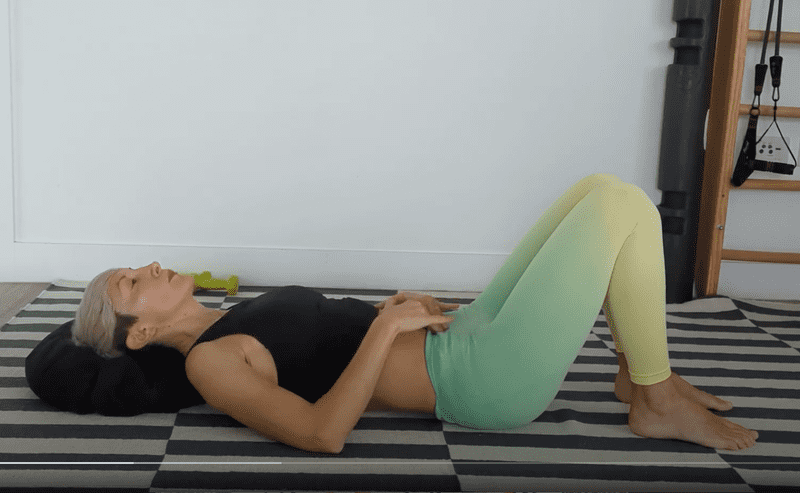Something I Couldn't Write About For Years
19 November 2023

It took me years to get comfortable writing about abdominal separation. I had started writing so many blog posts about it over the years, but would usually end up abandoning the whole thing halfway through.
One of the funniest of the titles of the deserted posts was ” The Things I Learnt From The Hole in My Belly”. It was a hole indeed. A fist-wide area above my navel where the connective tissue seemed to have been completely torn. Only the skin and a thin layer of fat was covering it, like an unconvincing pitfall trap, attempting to conceal a massive hollow with a handful of dry leaves.
After my second baby was born 1.5 years after I had a C-section with my first baby, my abdominal muscles didn’t even know how to talk to my brain. I remember my desperation while looking at the large, soft pregnant-looking belly that I couldn’t pull in anymore. Completely disconnected!
My belly seemed to be unable to hold itself together. If I did anything that required abdominal strength, my belly would be bulging and doming and my lower back and the left side of the waist would hurt for days.
Luckily, this story has a happy ending.
It took a while, but I managed to restore the neural drive to my deep abdominal muscles and coordinate them with the rest of the core.
Step by step, my body learnt how to use all the layers of the abdominal muscles and control the pressure inside my belly, so I could get stronger without getting injured again and again.
If you are lucky enough not to know what abdominal separation is, let me explain.
What is Abdominal Separation?
Abdominal separation, aka diastasis recti, is a separation of the left and the right side of the abdominal muscles along the midline, due to weakening or damage to the connective tissue where the muscles attach.
Why Do People Get It?
There are different reasons why people end up with abdominal separation - not just pregnancy and childbirth, but also heavy lifting combined with muscle tension or severe obesity could separate the abdominal muscles along the midline.
But whatever the cause, improving your intra-abdominal pressure management will help you break out of the re-injury pattern and allow the midsection to start recovering.
It’s Not The Distance, It’s The Function
The gap between the muscles is not the problem in itself – as long as the connective tissue is strong enough to offer resistance to the muscles.
For example, during the pregnancy, especially in the third trimester when there is no more space to expand, the crisscrossed tendons running across the front of the belly need to stretch to accommodate the baby. So, we have a distance between the two sides of the abdominal muscles, but that’s nothing to worry about. After the baby is born, the tendons recover and the gap decreases.
But sometimes, the connective tissue is too stretched to recover - and this is when we talk about diastasis recti. The tendons are overstretched like an old elastic in your pyjama bottoms and don’t have enough stiffness to handle the pull of the abdominal muscles.
So Can The Tendons Teal?
Yes, they can. Soft tissues take much longer to heal than muscles. Muscles are quick to heal and that is how we make them stronger. Every time we lift weights, we create microdamage in muscles so they grow stronger until the next training. But yes, tendons, ligaments and bones can and do heal.
But, if you have ever broken a leg, you know that you need to wear a cast to seal the bone and protect it from re-injury.
And that is exactly why diastasis recti is so hard to heal. The weakened tendons keep getting injured again and again.
The body struggles to manage the pressure inside the belly, straining the midsection, so the weakened connective tissue running across the front of your abdomen can’t heal.
This technically makes diastasis recti a repetitive strain injury.
How Do I Know If I Have Abdominal Separation?
Here is a video where I explain how you can test your belly for diastasis recti/abdominal separation in 1.5 minutes. Check it out.
⭐ We are checking not just the width but the depth of the gap
⭐ What is the integrity of the connective tissue?
⭐ Can it stiffen at effort?
If the connective tissue CAN stiffen when you cough or do a mini-crunch, it’s a good sign that you could heal the midsection effectively with exercise.
If the weak areas still feel weak and CAN’T stiffen up at effort - it might be a good idea to check with your GP if you could get a referral for a CT scan, to check how damaged the abdominal wall is and if you would need a surgery to repair it.
But even if you do need surgery, working on improving your intra-abdominal pressure management will help you heal quicker and avoid needing another surgery in the future.
As for me, I managed to get away without one - even though I was convinced surgery would be my only way out. My 6-fingers wide diastasis healed as I learned to manage the pressure inside my belly better, added progressive overload and started eating a lot of collagen.
Do you struggle with diastasis recti that is not getting better? Let me know if you need help.
❤️💪
Ivana xx